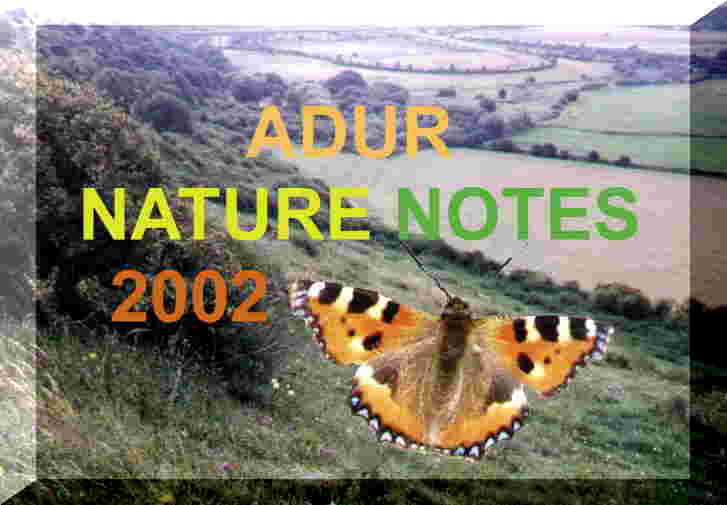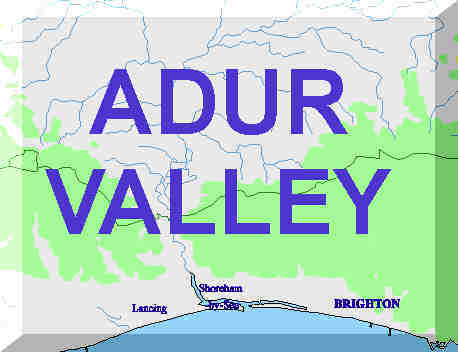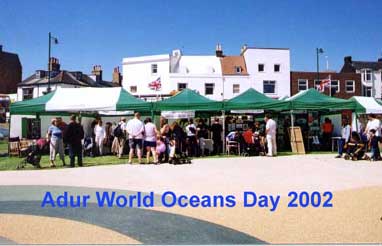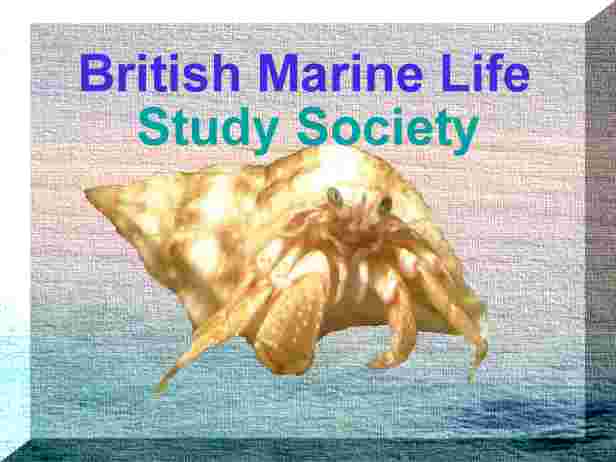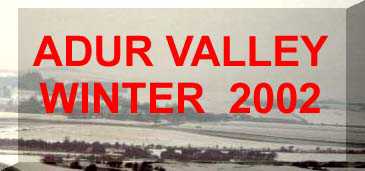27
September 2002
Hundreds
of Swallows flew
eastwards over the beach and Widewater Lagoon
this morning. I couldn't say if they were circling, perhaps getting as
far as Shoreham harbour and returning. Every one I saw was heading east.
I would estimate numbers at between 1 and 20 per minute. They were actively
feeding, some flying head high, sometimes swooping to ground level. Some
passed me within a couple of feet. Small groups of Goldfinches
occasionally took to the air as I passed the scrub where they gathered.
September
2002
The
new rock defences on the shingle beach are erected on Widewater beach with
rocks* brought in by barge across the North Sea from Norway.

Five
great heaps of rock looking like small volcanic islands sat on the beach
the last time I looked. Each waiting to be sculpted into a new groyne structure.
I stood watching the contractors as they were using a mechanical claw to
set rocks into place in a mound that will become one of the new groynes.
Full
Report
New
Rock Sea Defences on Widewater beach (complete web page)
Shoreham
beach (including Widewater beach)
25
September 2002
A
bird
of prey shot out rapidly from the ten
metres high
Hawthorn tree in our south
Lancing garden. (TQ 185 046)
It was in hot pursuit of a Sparrow it
had singled out from a group which flew off in all directions. This raptor
was probably a Kestrel
that habitually chase small birds in the autumn in Shoreham town.
NB: Observations
in 2004 rather suggest that this is a Sparrowhawk.
25
September 2002
Off
Lancing beach on the seaward side of Widewater, four Undulate
Rays, Raja undulata, were seen
in the shallow (4 metres depth) water.

Widewater
in Autumn
A small
dark bird skimmed over the sea at Kingston beach,
a flash of turquoise revealing it to be a Kingfisher.
An Oystercatcher probed
at low water.
At
7.15 am, a large owl fly slowly overhead,
over Eastbrook Road, south Portslade, East Sussex. The owl was being mobbed
by a flock of starlings. It did not fly in a straight line, but followed
an erratic flight path heading east.
The
owl had broad wings, short tail and a short rounded bead. The wings and
underside of the body appeared light and there was a dark marking on the
underside of each wing, towards the wing tip. As I was only a couple of
minutes from my house I was able to rush in and look through my reference
books while it was still fresh in my mind. It seems to match with the Short-eared
Owl, Asio
flammeus, both by artwork of underside
in flight and descriptive text.
I
have seen various birds of prey and this was different to anything I had
seen before. The image that sprang to mind was a Eagle
Owl that I saw at a display.
This diurnal
owl feeds mainly on small mammals.
NB:
The Short-eared Owl has been recorded before during the winter months
over the local coast, downs and Adur valley: the peak month is October
with 24 records in 15 year period and 10 records for September. (Shoreham
& District Ornithological Reports).
The
Sussex
Ornithological Society have this owl categorised
as a Passage Migrant (PM), Winter Visitor (WV) that has bred, for its records
in the county.
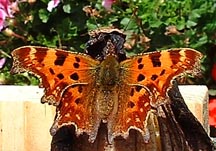 23
September 2002 23
September 2002
The
Autumnal
Equinox breeze was from the north-east but the Comma
Butterfly in Corbyn Crescent, Shoreham,
was fluttering against the wind until it settled in a Privet hedge
(TQ
22435 05275).
Adur
Butterflies
22
September 2002
Two
Thornback
Rays, Raja clavata,
300 mm across the wings were seen in very shallow water (3 metres depth
) off Shoreham beach.
Also
an over friendly Greater Pipefish,
Syngnathus
acus, which coiled around my friends neck, then swam straight into
the camera, then swam up to the surface where its mouth came up out of
the water!
Seas
off Sussex
BMLSS
Sharks and Rays
c.
21 September 2002
A
young Sparrowhawk was
observed hunting persistently but not very successfully on the east side
of the River Adur on the old railway track between the Railway Viaduct
and the Toll Bridge.
19 September
2002
A
squadron of 16 Cormorants,
immediately followed by another group of 17 Cormorants,
followed less than a minute later by a single straggler, flew up the River
Adur over the Toll Bridge. A few
minutes later a further 10 Cormorants
flew
together in the same direction.
A
very bedraggled normal livery Magpie
huddled in the lower branches of the Sycamore (TQ
2112 0532) occupied two weeks ago by the albino
Magpie. This bird looked ill or
beaten up.
17
September 2002
The
common Dot Moth,
Melanchra
persicariae, finds its way into houses at this time of the year. (TQ
22444 05295)

Slow
Worms (Photograph by Ray Hamblett)
16
September 2002
There
were large adult Slow Worms in
the grass and hiding under rocks and debris on the east side of the River
Adur near the Adur Industrial Estate (TQ
209 056).
15
September 2002
Comma
Butterflies are
numerous around Shermanbury.
Scores
of Red Admiral Butterflies
are seen in Shoreham town. Are these migrants from
the north, or butterflies blown over from France (where thousands of Red
Admirals have been spotted on a southerly
migration near le Haura)?
12
September 2002
The
distinctive long-legged spider Tetragnatha
extensa was discovered in the long grass near Widewater
Lagoon on the sea side.
11
September 2002
The
tide receded beyond the pier on Worthing beach
which was rather scantily inhabited by mobile fauna of interest to the
rockpooler.
However, of special interest was the discovery of a young Small-headed
Clingfish,
Apletodon
dentatus, in a shallow weedy pool south of the pier. All clingfish
have a pelvic (underside) find fused into a sucker, so when the cockle
shell is inverted (see the photograph underneath) the tiny fish remains
fastened to the shell.
British
Clingfish
Shorewatch
Biological Recording

A Clouded
Yellow Butterfly, the third occasion I
have seen them this year, fluttered over the Worthing promenade, finding
some garden plants planted by Worthing Borough Council.
10
September 2002
On
a five hour downs walk from Worthing to Shermanbury
on a bright sunny day with a good view of
the Isle of Wight from Cissbury Ring, I noted
that Speckled Wood Butterflies were
common everywhere with a few other butterflies
including a few Small Tortoiseshells
and Meadow Browns,
a couple of Comma Butterflies, a
Gatekeeper
and a single Peacock
Butterfly. Common Darter Dragonflies were
on the wing near Henfield and a group of at least a dozen impressive blue-black,
75 mm (3 inch) long dragonflies by the River
Adur.
The most likely species would seem to be the
Migrant Hawker, Aeshna
mixta.
Adur
Butterflies
In
the late afternoon, a Kingfisher flew
straight as an arrow from the amongst the Sea Purslane at half tide towards
the east bank of the Adur to the south of the Toll
Bridge. It was too far away to see its bright colours.
An
early morning low spring tide at Kingston
beach produced a young Black
Goby, a small fish that very alike
the commoner Rock Goby,
so alike that the first fish may be overlooked in tidal
pools. A Hermit Crab shared a periwinkle
shell with the commensal ragworm Neanthes fucata (=Nereis).
A Heron stood
by the water's edge as the tide rolled in.
9 September
2002
"There
are plenty of woods up here. I see Muntjac
Deer often on the bridle path going from
Frylands Lane, Wineham near Pooks Farm, to Kent Street, Wineham. In this
case I came round a corner on the road to the west of that path to come
across them. the path is not far away and it wooded both sides. And I'm
not 100% sure now, I only have someone else's word. I have seen them before
and at least one barked like a small dog. It was a resident of the area
that told me they were Monkjacks." These are very shy animals, small
(the size of a large dog) Asian deer that have escaped from private parks,
and when a pair of these deer spotted me they quickly ran off in
different directions in panic.
Upper
Adur East (Shermanbury area) Nature Pages
8 September
2002
A
Hummingbird
Hawk Moth,
Macroglossum stellatarum,
visited my Lancing garden (TQ 185 046),
nectaring on Ceratostigma plumbagnoides (Hardy
Plumbago).
Seven
Wasp
Spiders,
Argiope
bruennichi, were seen on my walk over Lancing
Ring (TQ 180 065). Three
specimens of the Autumn Lady's Tresses
Orchid, Spiranthes spiralis, were
discovered but on this relatively overcast day, there were few butterflies
about, but they included a Small Copper
Butterfly. A Green Bush Cricket
was spotted as well.
Earlier
Mill Hill Wasp Spider Report
Lancing
Nature Newsletter (September 2002)
Butterflies
of Lancing
7 September
2002
The
medium-sized dragonfly hawking around at just above head height
in St. Michael's Churchyard, Southwick, like a small version of the Emperor
Dragonfly was not identified as it would not remain still. The most likely
species would seem to be the Migrant Hawker,
Aeshna
mixta, which has now colonised the south-east of England.
5 September
2002
The
albino (white-winged) Magpie is back again. This time I was able to
place it high up in an ivy adorned Sycamore Tree (TQ
2112 0532) right at the southern end of the
old railway track running southwards from Old Shoreham to where it stops
abruptly at the demolished bridge. I first heard the bird from underneath
the tree at 6:30 pm
in the approach to the partially empty factory buildings on the Adur Metal
Works industrial estate. A normal black and white livery Magpie flew up
leaving a seagull-like albino Magpie perched in the tree. Its white breast
was spotted with black lines. By the time I had taken out my camera the
bird had hidden deeper amongst the ivy, unless it had flown to another
tree and I could not place where the call came from. This particular Sycamore
Tree is a veritable haven for wildlife, including a rich selection of insects
and butterflies of many species.
The
correct term is leucistic,
unless the bird has also lost the pigment in its eyes. I have not altered
the past entries because leucistic also refers to birds that have lost
only part of their pigment. A few years ago a leucistic Redshank
was a regular visitor to the lower Adur estuary,
but this bird was not nearly so white.
Magpies
disperse to new territories at this time of the year (Chris
Mead).
Previous
2001 Record
Bird
Information (by Chris Mead)
British
Trust for Ornithology
At
low tide by the Toll Bridge a bright
yellow/orange-legged juvenile Redshank
probed eagerly for food, so eagerly it did not give out its alarm call
and fly rapidly away.
4 September
2002
After
a dry spell, Widewater Lagoon had receded/dried
out/leaked and the small separate lagoon west of the western causeway was
reduced to a few puddles since 14 August 2002.
A
live Lagoon Cockle was found
on the surface.
Widewater
Salinity
29
August 2002
Alan
Barrett is pretty sure that he spotted a Mink
close to Woods Mill (Sussex Wildlife Trust HQ at Small Dole).
28
August 2002
Less
than a minute after opening my front (north facing) window of my flat in
Corbyn Crescent, Shoreham, (TQ 22444 05295)
a
good condition Peacock Butterfly
flew in, the first I had seen since 1 May
2002. It was also the first ever butterfly
that had entered my flat. A large female Emperor Dragonfly in Corbyn Crescent
was on a passage flight. This is a late record for this magnificent insect.
PS: I now think this was probably a Southern Hawker.
23
August 2002
A
seal, probably a Common (or Harbour) Seal,
Phoca
vitulina, was spotted off Lancing
beach between the breakwaters at high tide by the Golden Sands Caravan
Park. It was mistaken for a dog at first which is often the case. Seals
are a rare sight off the mid-Sussex coast, but a few have been seen off
Shoreham before. The nearest rookery is a small group of seals in Chichester
harbour which are occasionally seen around Selsey (Seal Island).
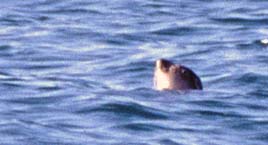
The
seal was also seen by Francis Garard
in the same area sharing the same swimming space with her in the morning
8:40
am on 29 August
2002.
Sussex Marine
Life
BMLSS
Seals
22
August 2002
An
immigrant Clouded Yellow Butterfly
fluttered in the breeze by the beach huts near Beach Green, Shoreham
Beach.
Adur
Butterflies
Mid-Late
August
A
pair of Bottle-nosed
Dolphins were seen by an angler and his
wife porpoising on a medium tide in the entrance to Shoreham
Harbour (outer Adur estuary).
Discussion
with a Lancing angler on 7 October 2002
21
August 2002
"It
was a huge caterpillar. At the head end were two very realistic
eye markings. The body was dark chocolate brown with lighter brown rings
and circles. The length was around 6 cm (2½ inches) and the girth
similar to the average thumb. When disturbed it either thrashed or made
S shaped movements. The tail end had a short horn. I would suggest it would
be a moth caterpillar. It was found on the ground close to a massive Virginia
creeper vine but numerous other plants were growing nearby."
This
caterpillar was discovered in
a garden in West Way, south Lancing, (TQ
198 042) on alluvial soil near the coast.
The
Elephant
Hawk-moths larvae display their eye spots when threatened. As it
is only these large moths (two British species)
that display large eye spots this is certainly what they are.
A Holly
Blue Butterfly fluttered by the ivy on
the railway line embankment at the southern end of Ravens Road (TQ
217 053), an area of note for urban wildlife
in Shoreham.
Brimstone
Moths are common and they are regularly
found indoors at this time of the year.
20
August 2002
After
finding the Wasp Spider,
Argiope
bruennichi, on Mill
Hill on 18 August 2002, another
one almost leapt at me down at Widewater Lagoon
(TQ 2008 0415) today.
This
one was close to the path across the causeway, I wasn't able to get
such
a good look at it but I think it was a male, about half the size of the
Mill
Hill specimen. I was distracted for a minute and when I looked back
the
spider
had 'legged it'.
Widewater
Page (by Ray Hamblett)
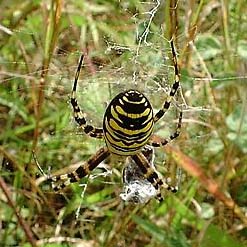 18
August 2002 18
August 2002
A
Wasp
Spider,
Argiope
bruennichi, was spotted on Mill Hill.
(TQ
211 076). This a distinctive European
continental species that has been spreading in the south-east. It was probably
an ovigerous female. This spider has been found in southern England since
the 1990's.
Butterfly
List
Ray
Hamblett's Mill Hill web page (with photographs of orchids and other wild
plants)
16
August 2002
 A
walk on the bridleway from the north side of Slonk Hill to Southwick
Hill (TQ 225 070 - TQ 225 078) revealed
the first Clouded Yellow Butterflies (8+)
since 2000. They were flying around rapidly and would not settle. Unlike
the Small Tortoiseshells (100+) which
were everywhere settling on Ragwort
and the bridleway. Most were brightly coloured, but there some faded ones
as well. The Painted Ladies (30+) preferred
the Greater Knapweed. Wall
Browns (40+) preferred to settle on bare
areas of chalk but made fleeting visits to Hardheads.
Gatekeepers
(25+), Small Whites
(15+), Meadow Browns
(15+) and at least one Red Admiral
completed the butterfly list. A
walk on the bridleway from the north side of Slonk Hill to Southwick
Hill (TQ 225 070 - TQ 225 078) revealed
the first Clouded Yellow Butterflies (8+)
since 2000. They were flying around rapidly and would not settle. Unlike
the Small Tortoiseshells (100+) which
were everywhere settling on Ragwort
and the bridleway. Most were brightly coloured, but there some faded ones
as well. The Painted Ladies (30+) preferred
the Greater Knapweed. Wall
Browns (40+) preferred to settle on bare
areas of chalk but made fleeting visits to Hardheads.
Gatekeepers
(25+), Small Whites
(15+), Meadow Browns
(15+) and at least one Red Admiral
completed the butterfly list.
I disturbed
a female Sparrowhawk on
a fence post, (near some bushes with many small brown birds), which glided
magnificently at at a low level across the open field.
Common
Darter
Dragonflies, Sympetrum striolatum,
flew
over the latitudinal bridlepath from Mossy Bottom to Southwick Hill (west
to east).
Adur
Dragonflies
15
August 2002
On
a hot (25° C) and
humid (82%) day,
I made a quick visit to Mill Hill. On a small
patch of the open (upper part of Mill Hill) meadows (TQ
212 073) the butterfly
count for an area of 20 square metres was high and the following species
were recorded in 15 minutes:

Chalkhill
Blue (60+)
Meadow
Brown (35+)
Small
Tortoiseshell (20+)
Painted
Lady (15+)
Wall
Brown (one)
Skipper
(one)
Common
Blue (one)
The
Chalkhill
Blue Butterflies were nectaring on Round-headed
Rampion,
Greater
Knapweed and
Hardheads. The Small
Tortoiseshells were overlooked in passing,
but when I stopped they appeared very colourful and frequent, feeding on
the occasional Ragwort
flower.
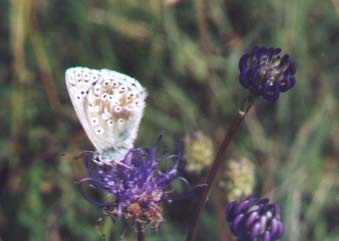 In
the scrub and longer grasses (TQ 211 076),
the Gatekeeper Butterfly
was surprisingly few in number and there were a handful, possibly many
more Common Blues,
the females with orange markings on their upper wings, feeding on grasses.
Meadow Browns were everywhere. In
the scrub and longer grasses (TQ 211 076),
the Gatekeeper Butterfly
was surprisingly few in number and there were a handful, possibly many
more Common Blues,
the females with orange markings on their upper wings, feeding on grasses.
Meadow Browns were everywhere.
In
the other meadows, there were additional numbers of Chalkhill
Blues, Meadow
Browns and Painted
Ladies.
Adur
Butterflies
Adonis
Blues and Common Blues Identification Tips
South
Downs Butterflies
Blue
Butterfly Flight Times
 Skylarks
were disturbed in the long grasses. Skylarks
were disturbed in the long grasses.
A
large (8 cm diameter) fungus was growing on a tree stump on the east side
near the bottom of the road leading to Mill Hill.
The
fungus is Polyporus squamosus, the Dryad's
Saddle which commonly appears in the early
summer and can reach large sizes (30 cm or more across). It grows on a
variety of deciduous trees. The broad flattened 'cap' with slightly darker
flattened areas or scales, the large honeycomb-like pores on the under
surface and the hard blackish stem are all characteristic.
British
Fungi Yahoo Group
14
August 2002
Widewater
Lagoon was very full of water for August
which
could be explained by the heavy rainfall of the last few days which caused
flooding in some places. The high tide of
6.1 metres (WXTide Table)
occurred at 4.27 pm BST and
the air bubbles shooting up through the cracks in the alluvium floor of
the lagoon began one hour before the high tide. They occurred as a steady
stream of small bubbles and sometimes as large less frequent bubbles and
these bubble points occurred more often in the shallow water but also could
be seen at the surface in water that was two metres deep. The conjecture
is that this is seawater being forced into the lagoon through the shingle
bank and the bubbling only occurs on tides of over 6 metres in height.
Widewater
Salinity
Tens
of thousands of very small (> 15 mm) prawns collected on the lagoon edges
amongst the pebbles. Bob Cranborne provided
the thin mesh net and the markings on the these prawns could be seen clearly
when looking down into the white bucket. They were too small for positive
identification with the naked eye. There is a possibility of the Lagoon
Prawn, Palaemonetes varians or perhaps the Common Prawn, Palaemon
elegans.
In
the surrounds of the causeway, I suddenly spotted a Ringed
Plover chick. the two parents were conspicuous,
part of their distraction behaviour, and altogether a small flock of
about 15 Ringed Plovers
wheeled noisily. Wheatears
were flying around as well, prior to emigration and the Mute
Swan couple were accompanied by nine
dirty grey cygnets. The Little
Egret seems to have deserted Widewater this
summer after being a regular every day visitor, if not virtually a resident
during he colder months.
A splendid
large and distinctive example of a female
Emperor Dragonfly buzzed overhead. (PS: This
may have been a Southern Hawker.)
Adur
Dragonflies
13
August 2002
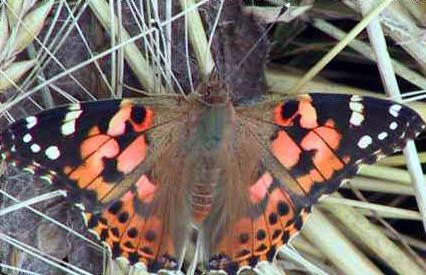 A
really mixed back of wildlife in the morning from an immigrant Painted
Lady Butterfly settled on a flower amongst
a flutter of various smaller butterflies
on Shoreham beach near the Church of the Good
Shepherd, where further along towards Widewater
at least a dozen Wheatears
were preparing for their flight back to Africa. A
really mixed back of wildlife in the morning from an immigrant Painted
Lady Butterfly settled on a flower amongst
a flutter of various smaller butterflies
on Shoreham beach near the Church of the Good
Shepherd, where further along towards Widewater
at least a dozen Wheatears
were preparing for their flight back to Africa.
On
Worthing
beach several hundred Sand
Gobies were present in the pools to
the south of the pier which were covered on bedrock weed of sufficient
variety to interest the phycologist.
Basking
on the airport road outside of Ricardo's Engineering Works, a Common
Lizard did not move as I cycled past. I stopped and tickled it under
the chin and then it skittered into the undergrowth.
12
August 2002
A
low spring tide forecasted at 0.2 on WXTides at Kingston
beach (Shoreham Harbour) receded past the tide marker for at least
20 minutes and the sand covered almost all the rocks.
Another
Sting
Winkle, Ocenebra erinacea, was
recorded and one orange coloured Common
Chiton, Lepidochitona cinerea.
The chiton was fixed to the underside of rock at mid-tide level, amongst
the loose rocks between the end of the groynes and the water line. This
is the usual place where these small (16 mm) oval rock-hugging molluscs
can be discovered, but they are not prevalent and can be easily overlooked.
One
of the venerids (bivalve mollusc), probably Venerupis
senegalensis (=pullastra) was
still alive on the surface under a rock.
A
large (20 mm) specimen of the distinctive small shrimp-like crustacean
Athanas nitescens was blue with a white stripe down its back, looking
formidable like a microscopic lobster, if it was not so tiny.
Fish
List for the Trip
10
August 2002
The
rainfall for the day totalled 34.6 mm.
Recent
Historical Records
 8
August 2002 8
August 2002
On
a breezy sunny and still humid day, the butterflies
on the old railway track south of the old Shoreham Toll
Bridge included Painted Ladies
(4+) possibly blown in from France, as well as the distinctive silhouettes
of the Red Admirals (4+), a
particularly bright orange of the Small
Tortoiseshell Butterflies (4+), with Small
Whites, Gatekeepers
and Meadow Browns,
all just a few.
5 August
2002
A
colourful Brown
Hairstreak Butterfly was seen in the fields
near Shermanbury Flats (was the Grange) between Shermanbury and Partridge
Green. This is eight miles due north of Shoreham-by-Sea.
Images
Allen
Pollard's Then & Now web pages

29-30
July 2002
 The
Daisy
Anemone,
Cereus
pedunculatus, has been discovered by Paul
Parsons off the outfall pipe near Brooklands boating lake. I (Andy
Horton) have discovered this sea anemone (that contains symbiotic
algae) on Worthing beach on one memorable occasion,
but at the moment this seems the most easterly discovery of this sea
anemone on the northern English Channel coast and shallow seas. The
Daisy
Anemone,
Cereus
pedunculatus, has been discovered by Paul
Parsons off the outfall pipe near Brooklands boating lake. I (Andy
Horton) have discovered this sea anemone (that contains symbiotic
algae) on Worthing beach on one memorable occasion,
but at the moment this seems the most easterly discovery of this sea
anemone on the northern English Channel coast and shallow seas.
BMLSS
Sea Anemones
29
July 2002
It
is very hot and humid with a temperature of 28.5° C was attained
during the day, and even at midnight it is 21.7 ºC with a humidity
of 81%.
28
July 2002
To
compare the butterflies on Mill
Hill with the ones seen yesterday in the Lancing
Clump meadows, I made a late afternoon visit and notes that the density
in a smaller area was at least twice as high but the variety of butterflies,
with just one pair of eyes, was smaller. Again in order of frequency, the
butterflies are listed:
 Gatekeeper
(200+) Gatekeeper
(200+)
Meadow
Brown (70+)
Marbled
White (35+)
Small
Skipper (25+)
Chalkhill
Blue (15+)
Red
Admiral
Large
White
Small
White
There
were hundreds of 6-Spot
Burnet
Moths in the long grasses.
The
blue butterflies in the medium length grasses would not settle with their
wings open, on the muggy humid day, and I could not instantly confirm their
identification. It is in a known Chalkhill Blue habitat and the underside
has an absence of any orange so it seems that Chalkhill Blue is probable.
Blue
Butterflies (Photographs 2000)
27
July 2002
Friends
of Lancing Ring have arranged for expert Brianne Reeve of the Butterfly
Conservation group to lead a walk over the reserve.

On
a hot (25° C) and muggy (humidity 86%) day, the walk produced an exceptional
variety of butterflies. In order of prevalence
these were:
Small
Skipper
Meadow
Brown
Gatekeeper
 Marbled
White Marbled
White
Holly
Blue
Common
Blue
Red
Admiral
Large
White
Small
White
Wall
Brown
Speckled
Wood #
Peacock
Large
Skipper
Small
Copper
Chalkhill
Blue #
(#
= hearsay reports)
The
last two were rarities in the meadows.
Both
could have been overlooked by a single naturalist. Small red
mites were present on some of the Meadow Browns.
6-Spot
Burnet
Moths were also common in the meadows.
Butterfly
Walk in August 2001
Butterflies
of Lancing
Adur
Butterflies
Shermanbury
Butterflies
UK-LEPS
Discussion Group (for Butterflies and Moths)

25
July 2002
The
Greater
Spotted Woodpecker who was on the bird
feeder in my Shermanbury
garden as it often is. And on the ground not far away, a parent Green
Woodpecker was feeding its youngster. So I had three woodpeckers within
five metres of my patio doors.
24
July 2002
Scores
of
Common Blue Butterflies
are disturbed at 8:00 am
on McIntyre's Field (TQ
188 061) near
Lancing
Clump.
In the
early evening, an Australian Black Swan,
Cygnus
atratus, was with about 18
Mute
Swans, between the Railway
Viaduct and Toll Bridge on the River Adur.
19
July 2002
An
evening walk through McIntyre's field and on to the chalk-pit.
The
sound of a million Grasshoppers, not a single Cricket.
Small
Skipper, Meadow Brown, Marbled White.
Warm
sun in soft evening light, gives lift to the butterflies flight
Small
Scabious and Black Knapweed,,
Pride
of Sussex - the Round-headed Rampion.
Pyramid
Orchid on a chalky slope
A
female Stag Beetle, But no male companion.
She
seemed exposed in the walkers route,
so
I carefully moved her to where she was safe from any boot.
Friends
of Lancing Ring
17
July 2002
A
small damselfly (probably the Blue-tailed
Damselfly, Ischnura elegans), landed
on my Lancing garden pond (TQ 186 044) and
it was immediately dragged down and killed and eaten by Common
Backswimmers (Greater
Water Boatman), Notonecta sp.
Freshwater
Life of North-western Europe Smart Group
On
a hot muggy day, it was the White Butterflies
that were noticeable, but there were Small
Tortoiseshell Butterflies on Adur Recreation
Ground and the towpath by the airport, likely to be more than the four
seen in passing.
15
July 2002
The
midday (12:35 pm) temperature was recorded at 26.2° C, the highest
of the year so far.
15
July 2002
An
alien moth that is seen in July in Shoreham, even coming indoors, is the
Brighton
Wainscot Moth,
Oria musculosa, a buff
creamy coloured moth. I
think this is most likely to be the Fen
Wainscot, Arenostola
phragmitidis.
At
Kingston
beach the brown pea-sized fry of the Lumpsucker
was
notable. The half a dozen Hermit Crabs
occupied shells up to dogwhelk size.
Rockpool
Fish List
14
July 2002
There
seems to be quite a few 22
spot Ladybird,
Psyllobora vigintiduopunctata,
around
amongst the undergrowth everywhere. The black spots on a yellow shield
are very clear and separated.
House
Martins are nesting in Eastern Avenue,
Shoreham, opposite the allotments, an area known for these summer immigrants.
13
July 2002
A
Hummingbird
Hawk-Moth was seen in urban upper Portslade.
(TQ
251 066)
11
July 2002
An
Australian
Black Swan, Cygnus atratus,
was
swimming underneath the Toll Bridge.
Lancing
Ring Report
9
July 2002
 Live
small cockles (new recruits of a breeding population) have now been discovered
at depths of 20 cm in Widewater, which was about
a metre deep near the bridge. This is the Lagoon
Cockle,
Cerastoderma glaucum,
although when the cockles are small (12 mm width) they do not have the
shape of the full grown ones, so they initially looked to me like Common
Cockles, Cerastoderma edule. Actually, whilst they are alive
there does not seem to be an easy way to distinguish them as it is the
interior groove differences that are diagnostic. The shell is thinner and
the Lagoon Cockle is brittler and the live
shell can be easily prised open with a fingernail which is much harder
with the Common Cockle, even small ones. The Shore
Crab, Carcinus maenas, would find
these shells very easy to crack open. Live
small cockles (new recruits of a breeding population) have now been discovered
at depths of 20 cm in Widewater, which was about
a metre deep near the bridge. This is the Lagoon
Cockle,
Cerastoderma glaucum,
although when the cockles are small (12 mm width) they do not have the
shape of the full grown ones, so they initially looked to me like Common
Cockles, Cerastoderma edule. Actually, whilst they are alive
there does not seem to be an easy way to distinguish them as it is the
interior groove differences that are diagnostic. The shell is thinner and
the Lagoon Cockle is brittler and the live
shell can be easily prised open with a fingernail which is much harder
with the Common Cockle, even small ones. The Shore
Crab, Carcinus maenas, would find
these shells very easy to crack open.
BMLSS
Cockles
The
black ooze (mud substrate) also revealed Nereis (ragworms), lugworms
and other assorted worms. The tiny gastropod Hydrobia was plentiful
as expected. There were also a few sediment-dwelling attachment type sea
anemones discovered, although these were not Edwardsia
ivelli. The
miniature sea anemones have been identified as a dwarf specimens of the
distinctive Haliplanella
lineata with orange stripes which are not found on other British
sea anemones. The anemone photographed was only 2 mm in height and 3 mm
in diameter and this was typical of the dozen anemones discovered in two
locations each side of the bridge.
This alien
anemone (accidentally introduced species) is a sea
anemone that inhabits harbours and estuaries and occasionally lagoons
where the
salinity is below full strength seawater.
Haliplanella
lineata attains at least 20 mm high and 13 mm diameter in British
specimens but in other parts of the world could be twice this size. Reproduction
by longitudinal fission is habitual
and frequent in this species. 
A Blenny
(a small green or grey rockpool fish), Lipophrys
pholis, was discovered by S. McKenzie
in Widewater near the bridge. This fish would not be able to enter the
lagoon naturally at present and would have been introduced by human activity.
It was not behaving naturally, it was slightly moribund. This is because
of the lowered salinity
of 24‰ (ppt). These rockpool fish
can only tolerate lowered salinities occasionally for short periods when
trapped in pools at low tide. If the unfiltered
pipeline is introduced, these fish will find their way into the lagoon
and unless they could escape through the pipeline, they will die within
a few weeks. Gobies, Pomatoschistus,
is another fish genus (two common species)
that would enter, but these fish have a short life less than two year span,
but the first year fry, with a greater tolerance of lowered salinity
(entering estuaries in the summer) would still
enter the lagoon and die in the first winter. Shore Crabs have an even
greater tolerance of lowered salinity, able to osmoregulate better in higher
summer water temperatures, but even with this hardy crab, they would find
it difficult to survive a winter unless they congregated in more saline
pockets. These crabs will predate on cockles and worms in the lagoon mud.
8 July
2002
At
least one live Lagoon Cockle, Cerastoderma
glaucum, is discovered in the mud
samples taken from deeper water yesterday.
7
July 2002
The
trip in the unseasonal drizzle to Widewater Lagoon,
ostensibly in the search for the sea anemone Edwardsia
ivelli, but actually the collection
of anaerobic mud and hundreds of dead shells of the Lagoon
Cockle, Cerastoderma glaucum,
with just the remotest long shot that
something interesting would creep out. The black mud substrate was collected
at two locations one west of and one east of the bridge on the shallow
edge of the deepest bits of the lagoon. After the recent rain, the lagoon
was still appreciably filled and showed no signs of drying out that can
occur in hot summers.

 The
failure to discover even one live cockle was
disappointing. Probably the collection area had actually dried out completely
during a recent dry summer and the mass mortality was because of desiccation. The
failure to discover even one live cockle was
disappointing. Probably the collection area had actually dried out completely
during a recent dry summer and the mass mortality was because of desiccation.
"As
some lagoons are prone to ephemerality it is in their nature to experience
wide fluctuations in populations of species. When I have recorded
Cerastoderma
glaucum at sites I have almost always found many many more dead shells
than living. Terry Wimbleton (Havant)
of the Conchological Society
has observed see-saw colonisation of suitable habitat for Cerastoderma
glaucum locally (Dorset to Sussex) and was talking to me about this
at a meeting recently."
Marlin
on C. glaucum
Widewater
Salinity
The
first green spiky shoots of Glasswort
were clear in the boggy and almost dry margins. Floating on the surface
the strands of the rooted plant with the scientific name of Ruppia
maritima were pointed out. This is an unattractive choking
style green flowering point that was present in large clumps. Despite its
prominence this is the first record of it on these Nature
Notes pages.
Widewater
Page
Widewater
Lagoon page (by Ray
Hamblett)
 6
July 2002 6
July 2002
The
Small
Skipper Butterflies are flying about near
Shermanbury.
These primitive butterflies are common enough in the summer months and
have featured before in the lists of species from the chalk downs. The
Essex
Skipper is a very similar species with a black
tip to its antennae.
Adur
Valley Butterflies (Link)
UK-LEPS
Discussion Group: Messages
(Small and Essex Skippers)
4 July
2002
Public
Exhibition of the Lancing Rocky Sea Defence
Plan on the seaward side of Widewater
Lagoon. The most controversial proposal seems to the the inclusion
of a seawater pipeline.
Information
Page
The Habitat
Action Plan for Sussex on Saline Lagoons has been published by WSCC.
UK
Biodiversity: Action
Plan for Saline Lagoons
Adur
Biodiversity: Notes on Action Plan
1 July
2002
Adur
World Oceans Day Meeting

|

